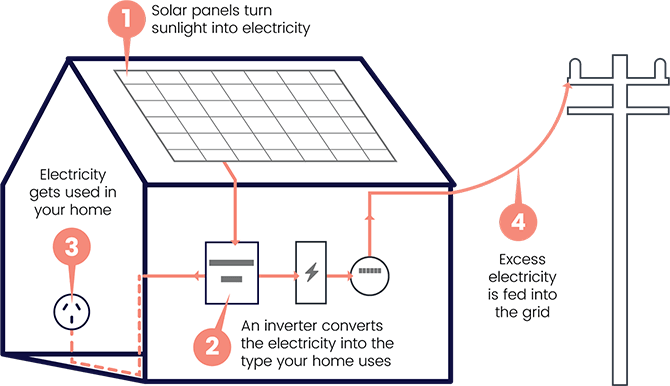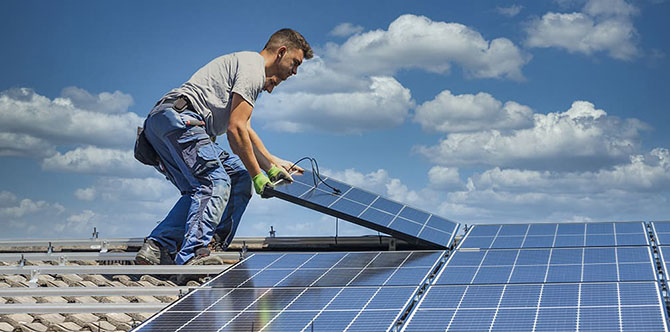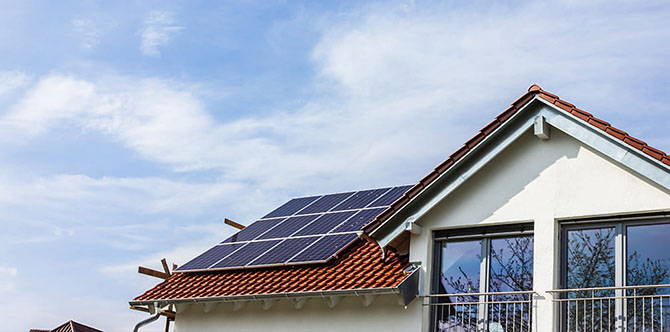Solar energy is a source of renewable energy harnessed from the sun. Solar panels capture sunlight and transform it into electricity, powering homes and businesses throughout Australia. This clean and sustainable energy solution reduces reliance
on fossil fuels, paving the way for a more environmentally friendly future.
Millions of Aussie roofs are basking in the glory of energy independence – one of the major benefits of solar energy. If you’re thinking about installing a solar power system yourself, here’s the lowdown on how they work
and what’s happening in the solar industry in Australia.
Types of solar energy
There are two main types of solar energy: solar thermal (which uses solar radiation to heat air or liquid, like in solar water heating) and solar photovoltaic. In this article, we talk about solar photovoltaic (or pv solar), which is made
when you convert sunlight into electricity. To make electricity, solar panels absorb light and use it in a way that creates electrical energy.
That energy is converted into the type of electricity we use in our homes. So long as panels produce enough energy, the electrical items in our homes get the power they need from the sun, instead of relying on electricity from the grid. When
you hear the term ‘off-grid’, it refers to homes that are able to operate exclusively on the electricity they generate themselves.
How does solar energy work?
A solar panel is full of photovoltaic solar cells, which is science for ‘things that turn light into electricity.’ (This is known as a solar photovoltaic system, also referred to as solar PV).
When sunlight reaches each solar cell, it ‘excites’ electrons in the cells, causing them to move. Moving electrons = electrical energy. That energy moves out of your panels and into a solar inverter.
A solar what?
Solar inverters turn the solar electricity coming out of your panels into energy your electrical items can use, completing the solar to energy transformation. The inverter is connected to your switchboard which lets you use electricity when you need it, and (if your solar set-up
supports it) feeds it into the grid when you don't.

What is solar energy used for?
You can only produce solar electricity when the sun shines. When it doesn’t, your property will pull energy from the grid. This means your solar energy typically powers the electrical appliances you use during the day.
If you want to limit your reliance on the grid (and keep your home solar-powered for more of the day) you could also install a battery. It stores excess solar power to use when the sun’s not out.
Advantages of solar energy
Solar could save you money
Sunshine is free, and the energy from your solar-electric system is free as well. Every bit you use is power you don’t have to purchase from the grid. You can also get set up to send any spare solar energy out into the grid in exchange
for credits on your bills. Waste not, want not.
Solar is sustainable
Solar power is a type of renewable energy – it doesn’t use finite resources like fossil fuels*, so it’s a more sustainable way to power
your home. Not to mention, the process of creating electricity in your solar panels doesn’t create any pollution.
Is solar power worth it?

That all depends on your situation, so here are a few things to think about before installing solar panels.
1. Solar installation is a financial commitment
The upfront cost of solar panels means that they’re a long-term investment. Think about whether you’ll be staying at your property long enough for your solar savings to give you a positive return on the money you’ve invested.
It’s worth looking into the solar financing options and rebates that are available, and using a solar calculator to get an idea of how long it might take for you to see a return. Learn why solar panels could be the best way to increase your property’s value.
2. Low daytime use delays your return on investment
If your property is mostly empty during the day, it probably doesn’t use much power when the sun’s out – unless you’re running heavy users like swimming pools. Since solar power is only produced when the sun shines,
you could be producing much more than you need.
Even though you could get money back for the extra energy you produce (which goes back in the grid), it’s more cost-effective for most people to use solar power as it’s generated **.
3. It’s possible to save your leftovers, but you’ll need a battery
Your house might not use all the power you produce while the sun’s shining, but you can save it for later using battery storage. It’ll let you use more of your solar power, but also means extra upfront costs.
4. Your panels need a solar-friendly home
Is there somewhere you can install your panels where they’ll get enough sun? Shade from trees and other buildings, as well as the direction your panels face are all important factors when considering to invest in a solar system. And
while there’s plenty of solar energy information online, getting a solar installer (or three) around means you can get information that’s tailored to your place.
5. Savings vary between properties
There are state and federal schemes that will subsidise your solar PV system, so long as you’re eligible for them. If you do decide to install solar panels, speak to your installer to find out if you qualify and how the subsidy will
be arranged.
The future of solar energy in Australia
The average Aussie home has real solar generator potential – plenty of sun, with plenty of room to install solar panels. In 2020 alone, Australian rooftops added 3 GW of rooftop solar capacity across almost 380,000 installations (that’s
a bigger increase than any other year).

You might’ve heard about how – for a sunny hour in 2020 – South Australia was able to run exclusively on solar power. Sounds good, right? And it is. But it comes with another challenge: what happens when we’re generating
much more than we’re able to use?
Traditionally, electricity comes from power plants and gets distributed via the grid to individual properties. With residential solar in the picture, that process is reversed; we’re now seeing solar electricity travel from homes into
the grid.
Although our power networks can work this way, they’re not set up to do it at scale.
So, when energy goes back into the grid from multiple homes, it can cause ‘energy traffic jams’ which lead to voltage and frequency problems. At that point, you risk localised blackouts and things tripping off.
So now the challenge is to work out how we keep reaping those solar energy benefits without causing problems for the grid. So far, there’s no perfect solution, but there are plenty of ideas about how it could be done:
1. Upgrade the grid
Makes sense, right? If we changed our grid to cope with these distributed energy sources, there’d be no problem. The drawback is cost – estimated at around $1.4 billion in a 2017 CSIRO report – which ends up on power bills
(whether you have solar or not).
2. Turn solar off when supply is high
With the right technology, home solar systems can be monitored and controlled remotely. Then – when too much solar is being generated – they can be effectively ‘cut off’ from contributing to the grid. In this scenario,
the question is who misses out on exporting their energy for solar credit, and should they be compensated?
3. More home batteries
The more energy homes can store and use themselves, the less they need to worry about exporting. Like grid upgrades, the problem is cost – not everyone will have the money for a home solar battery without sufficient subsidies.
4. Use homes like mini power-plants
A major problem with the current system is that there’s not a lot of oversight over how much energy individual homes are generating and exporting. If we can start monitoring homes as a whole, integrated system, we can start using them
more harmoniously (which means greater stability for the grid). Of course, this relies on those customers agreeing to hand control over their power to someone else, and having the solar technology to make it work as smoothly as possible.
5. Running cars on sunshine
As more and more people start driving electric vehicles (EVs), there’s an opportunity to steer (get it) people in the direction of charging them during peak solar hours to make use of some of that sweet, cheap energy.
The industry is still working out the way forward, but there’s no doubt solar users can expect pretty big changes to the way we use energy systems in the future. So if you’re thinking of going solar, it’s worth getting a
few opinions on the best way to do it first.
Solar energy facts

Infographic summary
- In 2020, small-scale solar overtook hydropower to become the second largest source of renewable energy in Australia.
- Large-scale solar is getting smarter: The DHL distribution centre in western Sydney is home to a commercial solar project that supplies electricity to the site as well as trading directly with the wholesale
market.
- The average size of solar systems in Australia has risen from 1.97 kilowatts (kW) in 2010 to 8.04kW in 2020.
- As large-scale solar projects get larger, so does the challenge to solar installers. The result? Using helicopters to put PV panels in place at the Woolworths headquarters in Sydney.
- South Australia, eat your heart out. The Sun Cable project in the Northern Territory (set to start generating in 2026) will be the world’s largest solar power plant, with a battery 150 times bigger
than SA’s Hornsdale Power Reserve.
The solar industry is changing right under our noses, so some of this information might be out of date when you read it. Feel free to let us know at marketing@momentum.com.au
*To answer your question (or address that raised eyebrow) technically yes, the sun is a finite resource. But science gives it another 5 or so billion years, and we assume we’ll be firing laser energy from our eyeballs by then anyway.
**If you’re on a government solar scheme, this might not be the case. Check your rates to decide how your solar is best used.
Related Posts:Empty heading